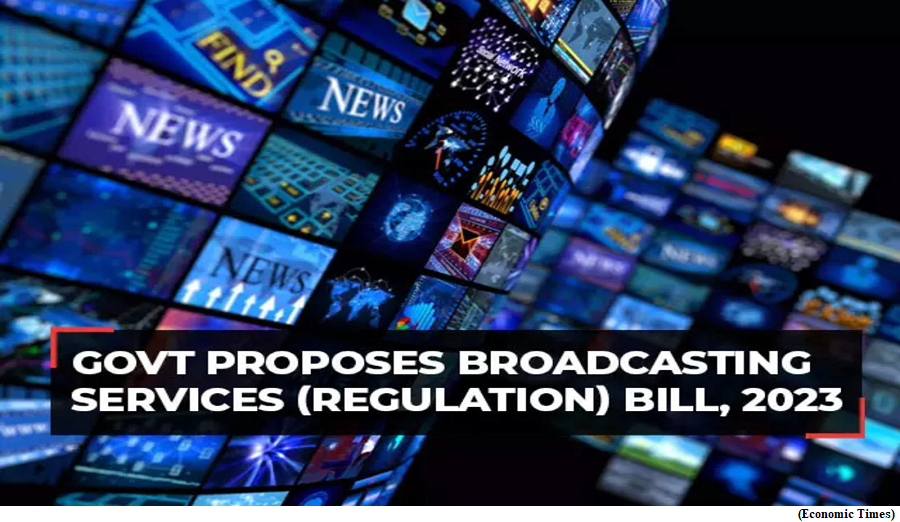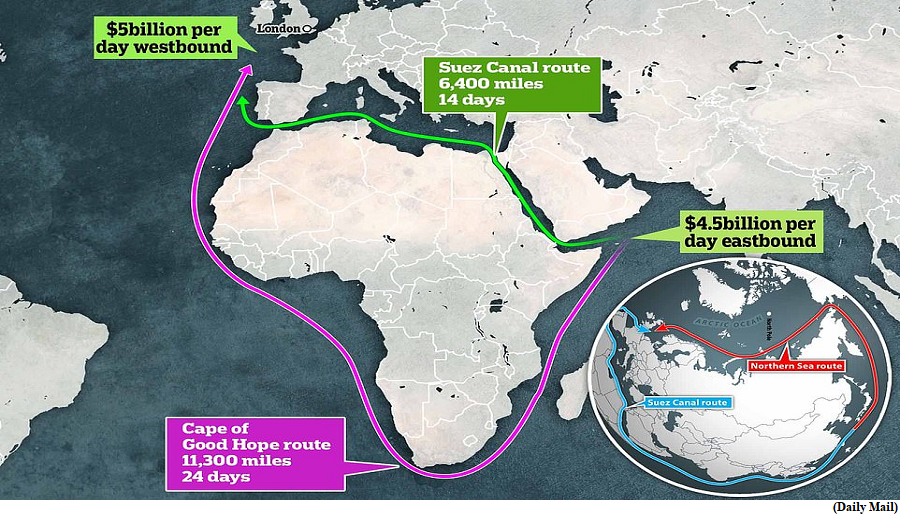Broadcasting Services (Regulation) Bill, 2023 (GS Paper 2, Governance)

Why in news?
- Ministry of Information and Broadcasting, Government of India has proposed a draft Broadcasting Services (Regulation) Bill, 2023.
- The draft Bill provides for a consolidated framework to regulate the broadcasting services in the country and seeks to replace the existing Cable Television Networks (Regulation) Act, 1995 and other Policy Guidelines currently governing the broadcasting sector in the country.
Details:
- The Bill streamlines regulatory processes, extends its purview to cover the Over-the-Top (OTT) content and digital news, and introduces contemporary definitions and provisions for emerging technologies.
- It seeks to provide for Content Evaluation Committees and a Broadcast Advisory Council for self-regulation, different program and advertisement code for different Broadcasting Network Operators, Accessibility measures for persons with disabilities, and statutory penalties, etc.
- The Bill comprises of six Chapters, 48 Sections and three Schedules.
Key Highlights:
Consolidation and Modernization:
- It addresses a long standing need of consolidating and updating the regulatory provisions for various broadcasting services under a single legislative framework. This move streamlines the regulatory process, making it more efficient and contemporary.
- It extends its regulatory purview to encompass broadcasting over-the-top (OTT) content and digital news and current affairs currently regulated through IT Act, 2000 and regulations made there under.
Contemporary Definitions and Future-Ready Provisions:
- To keep pace with the evolving technologies and services, the bill introduces comprehensive definitions for contemporary broadcasting terms and incorporates provisions for emerging broadcasting technologies.
Strengthens the Self Regulation Regime:
- It enhances self-regulation with the introduction of ‘Content evaluation committees’ and evolves the existing Inter-Departmental Committee into a more participative and broader ‘Broadcast Advisory Council’.
Differentiated Programme Code and Advertisement Code:
- It allows for a differentiated approach to Programme and Advertisement Codes across various services and require self-classification by broadcasters and robust access control measures for restricted content.
Accessibility for Persons with Disabilities:
- The bill addresses the specific needs of persons with disabilities by providing for enabling provisions for issue of comprehensive accessibility guidelines.
Statutory Penalties and Fines:
- The draft Bill introduces statutory penalties such as: advisory, warning, censure, or monetary penalties, for operators and broadcasters. Provision for imprisonment and/or fines remains, but only for very serious offenses, ensuring a balanced approach to regulation.
Equitable Penalties:
- Monetary penalties and fines are linked to the financial capacity of the entity, taking into account their investment and turnover to ensure fairness and equity.
Infrastructure Sharing, Platform Services and Right of Way:
- The bill also includes provisions for infrastructure sharing among broadcasting network operators and carriage of platform services. Further, it streamlines the Right of Way section to address relocation and alterations more efficiently, and establishes a structured dispute resolution mechanism.
Way Forward:
- Technological advancements have introduced new platforms such as DTH, IPTV, OTT, and various integrated models.
- With the digitization of the broadcasting sector, especially in cable TV, there is a growing need to streamline the regulatory framework.
Digital Advertisement Policy, 2023
(GS Paper 3, Science and Technology)
Why in news?
- The Ministry of Information and Broadcasting has approved a path breaking Digital Advertisement Policy, 2023 to enable and empower the Central Bureau of Communication which is the advertising wing of the Government of India to undertake campaigns in the Digital Media Space.

Why it matters?
- This policy marks a pivotal moment in CBC's mission to disseminate information and create awareness regarding various schemes, programs, and policies of the Government of India in response to the evolving media landscape and the increased digitalization of media consumption.
- The huge subscriber base in the Digital Universe, coupled with technology enabled messaging options through Digital advertisements will facilitate effective delivery of citizen centric message in a targeted manner, resulting in cost efficiencies in public oriented campaigns.
Digital India program:
- The Government of India’s Digital India program has led to a huge growth in the number of people in the country who are now connected to the internet, social and digital media platforms.
- As per TRAI’s Indian Telecom Services Performance Indicators January–March 2023, the internet penetration in India as of March 2023, is over 880 million, and the number of telecom subscribers as of March 2023 is over 1172 million.
Key Highlights:
- The Policy will enable CBC to empanel agencies and organisations in the OTT and Video on Demand Space. CBC will also be able to leverage the growing number of listeners to Podcasts and Digital Audio platforms through empanelment of Digital Audio platforms.
- Apart from rationalising its process of empanelling Internet Websites, CBC now for the first time will be able to channelize its public service campaign messages through Mobile Applications too.
- It further streamlines the process through which CBC can place advertisements for government clients on these platforms. The policy also empowers CBC to empanel Digital Media Agencies to enhance its outreach through the various platforms.
- The CBC's Digital Advertisement Policy, 2023, introduces competitive bidding for rate discovery, ensuring transparency and efficiency. Rates discovered through this process will remain valid for three years and will be applicable to all eligible agencies.
Significance:
- The outreach of government Ministries and departments will be further supplemented by Ministry of Information and Broadcasting’s Media Unit, Central Bureau of Communication which is the designated organisation for issue of advertisements through all forms of media.
About CBC:
- The Central Bureau of Communication (CBC) operates under the Ministry of Information and Broadcasting and is responsible for creating awareness and disseminating information about various government programs, schemes, and policies in India.
An alternative to the Suez Canal
(GS Paper 2, International Relation)
Why in news?
- It has been speculated that one of the reasons behind Israel’s desire to eliminate Hamas from the Gaza Strip and completely control the Palestinian enclave is to give itself the chance to better explore a dramatic economic opportunity that has been talked about for several decades, but for which peace and political stability in the region is an essential prerequisite.

Ben Gurion Canal Project:
- The Ben Gurion Canal Project, named after Israel’s founding father David Ben-Gurion (1886-1973), remains one of the most ambitious infrastructure projects ever planned on paper.
- The idea is to cut a canal through the Israeli-controlled Negev Desert from the tip of the Gulf of Aqaba, to the Eastern Mediterranean coast, thus creating an alternative to the Egyptian-controlled Suez Canal that starts from the western arm of the Red Sea and passes to the southeastern Mediterranean through the northern Sinai peninsula.
- The Ben Gurion Canal Project was first envisioned in the 1960s would, if it were to be actually completed, transform global maritime dynamics by taking away Egypt’s monopoly over the shortest route between Europe and Asia.
- However, any attempt to construct the canal would have to overcome gigantic logistical, political, and funding challenges which, in the current situation, makes it seem largely fantastical.
Suez Canal:
- When it opened in 1869, the Suez Canal revolutionised global maritime trade.
- By connecting the Mediterranean and Red Seas through the Isthmus of Suez, it ensured that ships travelling between Europe and Asia would not have to travel all the way around the continent of Africa.
- The canal cut the distance between London and Bombay (now Mumbai) by a more than 41 per cent.
- In the 2022-23 fiscal year, around 26,000 vessels crossed the Suez Canal, accounting for approximately 13 per cent of global shipping.
Issues with Suez Canal:
- The 193 km-long, 205 m-wide, and 24 m-deep Suez Canal is the world’s biggest shipping bottleneck. Despite being widened and deepened over the years, it remains perennially congested, with long queues at either end.
- In March 2021, the mammoth cargo ship Ever Given got stuck in the canal, blocking passage for more than a week. It was estimated that the resulting “traffic jam” held up an estimated $ 9.6 billion of goods every day.
Source of conflict:
- Also, Egypt’s control over the waterway has been a source of conflict for almost 70 years now. In 1956, after President Gamal Abdel Nasser (1918-70) decided to nationalise the canal, war broke out, with the UK, France, and Israel attacking Egypt in order to regain control.
- The Suez Crisis ended in a military victory for the aggressors but an overwhelming political victory for Egypt, which kept control over the canal, which was shut for more than six months due to the conflict.
- This was also a pivotal moment in the Cold War, with Soviet threats of intervention key to stopping the allied aggression against Egypt.
- The Suez Canal was also the focal point of both the 1967 and 1973 Arab-Israeli wars, and was shut from 1967-75.
Economic value:
- The canal is, of course, critical to Egypt’s economy. It collects all the toll revenue generated, in addition to the benefits it brings to its local economy.
- In the 2022-23 fiscal year, Egypt’s Suez Canal Authority saw toll revenues reach a record $ 9.4 billion, accounting for nearly 2 per cent of Egypt’s GDP of $ 476.8 billion. Thus, for the West, a shipping lane through Israel would be ideal.
What has stopped Israel from constructing the canal?
- Such a project would be extremely complex and almost prohibitively expensive. The estimated cost of such a project may be as high as the $ 100 billion, much more than what it might take to widen the Suez Canal and solve its traffic problem.
- It was the cost of digging such a canal conventionally that made planners look at the nuclear option. Of course, the risk of nuclear fallout makes this option extremely risky as well.
- Costs aside, the planned route of the Ben Gurion Canal is over 100 km longer than the Suez Canal, primarily due to limitations of the terrain and topography. Even if built, many ships might still favour the older, shorter route.




